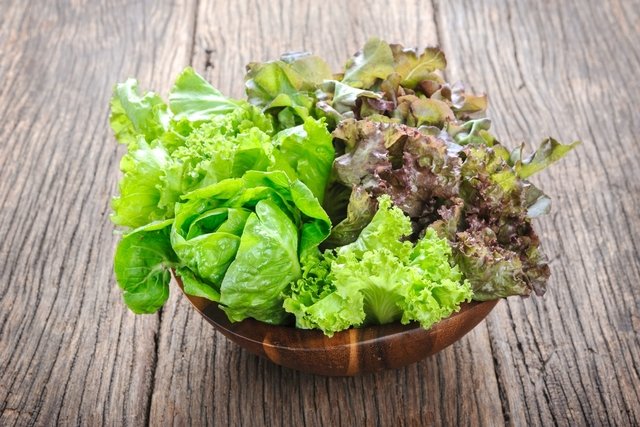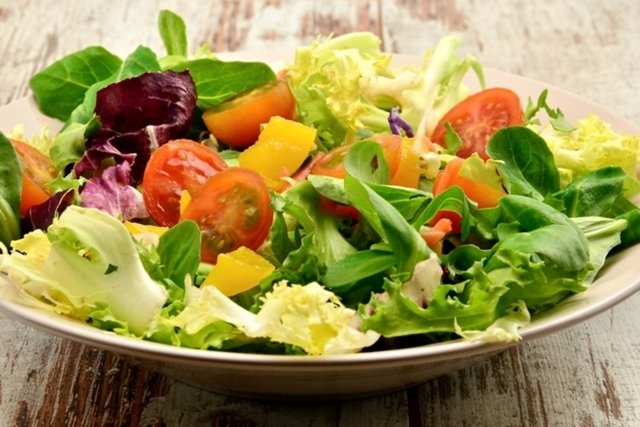Lettuce is a vegetable rich in fiber and antioxidants, promoting weight loss, improving gastrointestinal health and regulating blood sugar levels. These benefits are also provided by the nutrients and bioactive compounds present in lettuce, such as vitamin C, carotenoids, folates, chlorophyll and phenolic compounds, which guarantee hypoglycemic, digestive, antioxidant, diuretic, laxative and calming properties.
Lettuce can be easily incorporated into your daily diet, and can be used to prepare salads, juices and teas. Lettuce can also be grown at home, all it needs is a small pot, lots of sunlight and water to grow.

Health benefits
Regular consumption of lettuce could bring the following health benefits:
1. Promotes weight loss
Lettuce is a vegetable that is low in calories and rich in fiber, which promotes a feeling of satiety and promotes weight loss.
2. Helps regulate blood sugar
The fiber present in lettuce makes the absorption of carbohydrates in the intestine slower, preventing a rapid increase in blood sugar and, therefore, it is an excellent option for diabetic or pre-diabetic people.
3. Maintains eye health
Lettuce is rich in vitamin A, an important micronutrient for maintaining eye health, preventing xerophthalmia and night blindness, as well as preventing macular degeneration associated with age.
4. Prevents premature skin aging
Thanks to its antioxidant content, consuming lettuce helps protect skin cells from damage caused by free radicals. In addition, it provides vitamin A and vitamin E, which protect the skin from the sun’s ultraviolet rays, and vitamin C, which is important for the healing process and collagen production in the body, thus promoting the formation of wrinkles.
Lettuce is also rich in water, helping to keep the skin properly hydrated.
5. Maintains bone health
Lettuce is rich in several minerals such as calcium and phosphorus, which are related to the formation of bones. In addition, it also contains magnesium, which is part of the calcium absorption and assimilation process, as it suppresses the action of the hormone responsible for bone reabsorption.
Furthermore, this vegetable also contains vitamin K, which is also related to strengthening bones.
6. Diseases and anemia
Because it contains folic acid and iron, consuming lettuce can also prevent and treat anemia, as these are minerals related to the formation of red blood cells. Due to the type of iron that lettuce provides, it is important that foods rich in vitamin C are also consumed so that intestinal absorption is favored.
7 Helps fight insomnia
Lettuce has calming properties that help reduce stress and excitability of the central nervous system, helping to combat insomnia and making the person sleep better.
8. Has antioxidant action
Lettuce is rich in antioxidants, as it contains vitamin C, carotenoids, folates, chlorophyll and phenolic compounds, which prevent damage caused by free radicals to cells and, therefore, its regular consumption could help prevent chronic diseases, including cancer.
9. Fights constipation
Because it is rich in fiber and water, lettuce favors the increase in the size of stool and its hydration, favoring its exit and being an excellent option for those who have constipation.
10. Combats fluid retention
Regular consumption of lettuce helps reduce fluid retention, as it is a vegetable rich in water, so that for every 100g there are 95.9 grams of water, which helps to stimulate the elimination of excess water through urine.
Types of lettuce
There are several types of lettuce, the main ones being:
- Americana or Icebergwhich is characterized by being round and having light green leaves;
- Lisain which the leaves are smoother and softer;
- Frizzwhich has leaves with waves at the end, in addition to being smooth and soft;
- Romanain which the leaves are wider, longer and curly and dark green in color;
- Purplewhich has purple leaves.
These types of lettuce have similar properties, with variations in the amount of nutrients, as well as differences in texture, color and flavor.
Nutritional information
The following table shows the nutritional composition of 100 g of plain and purple lettuce:
How to consume
To obtain all the benefits of lettuce mentioned above, it is recommended to eat at least 4 lettuce leaves per day, preferably with 1 spoon of olive oil, as this way it is possible to increase its antioxidant power, as well as being part of a balanced and balanced diet. healthy.
Lettuce can be added to salads, juices and sandwiches, and should be stored in the refrigerator to preserve its folic acid and vitamin C content.
To preserve the leaves for longer, you should use a container with a lid and place a napkin or paper towel at the bottom and top of the container, as this will absorb the moisture from the leaves, making them last longer. . Additionally, you can also place a napkin between each sheet, remembering to change the paper when it is too damp.
Lettuce recipes

Below are some easy and healthy recipes with lettuce:
1. Stuffed lettuce roll
Ingredients:
- 6 smooth lettuce leaves;
- 6 slices of light Minas cheese or ricotta cream;
- 1 small grated carrot or ½ beetroot.
Sauce
- 2 tablespoons of olive oil;
- 1 tablespoon of water;
- 1 tablespoon of mustard;
- 1/2 tablespoon of lemon juice;
- Salt and oregano to taste.
Preparation mode
Place a slice of cheese, ham and 2 tablespoons of grated carrot on each lettuce leaf, rolling the leaf and securing it with toothpicks. Place the rolls in a container, mix all the sauce ingredients and drizzle over the rolls. To make the roll more nutritious, you can add shredded chicken to the filling.
2. Lettuce salad
Ingredients
- 1 iceberg lettuce;
- 2 grated carrots;
- 1 grated beet;
- 1 tomato without skin and seeds;
- 1 small mango or 1/2 large mango cut into cubes;
- 1 onion cut into slices;
- Olive oil, vinegar, salt and oregano to taste.
Preparation mode
Mix all the ingredients and season with oil, vinegar, salt and oregano. This salad can be used as a side dish or starter for main meals, helping to increase satiety and control the absorption of carbohydrates and fats in the intestine.
3. Lettuce tea
Ingredients
- 3 chopped lettuce leaves;
- 1 cup of water.
Preparation mode
Boil the water with the lettuce leaves for about 3 minutes. Then strain and drink while still warm at night to combat insomnia.
4. Apple lettuce juice
Ingredients
- 2 cups of lettuce;
- 1/2 cup chopped green apple;
- 1/2 squeezed lemon;
- 1 tablespoon of rolled oats;
- 3 cups of water.
Preparation mode
Mix all the ingredients in a blender and drink 1 glass of cold juice.




